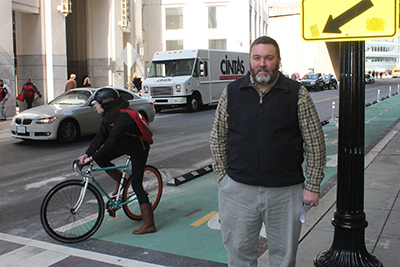
COG Transportation Engineer Andrew Burke
Back in 2007, The Washington Post did a feature on the Council of Governments’ travel monitoring studies highlighting the traffic counting crews and COG staff members who manage the studies. The District of Columbia Department of Transportation’s Jim Sebastian, a former COG employee, was one of the many people to read the story, and he approached his onetime colleague Andrew Burke with a question: could COG count bike trips for the District of Columbia?
And so began COG’s monitoring of non-motorized travel, particularly bicycles. Andrew has managed COG's annual bicycle counting program for DDOT since 2008. The original study involved about 30 locations. DDOT has expanded the program to 50 locations after seeing the value of the count data to its planning efforts. For example, Andrew recalls data from the 15th Street Cycletrack showing people going in both directions—not just South—during the morning rush hour. This informed DDOT on commuting patterns in more detail than they previously had available.
Virginia was the next jurisdiction to seek out COG’s assistance on bike counts. The Virginia Department of Transportation annually conducts a series of bicycle counts using several specially designed mobile video cameras. VDOT had performed some initial data collection with the new technology and asked COG to validate the results. Through their work, Andrew and his team demonstrated to VDOT the importance of proper deployment of their equipment, and it resulted in the COG Travel Monitoring section performing the counts.
Most recently, the Maryland Department of Transportation approached COG about monitoring bike activity. Andrew and his field team conducted a "before" count on the Bladensburg Waterfront Park Riverside Trail in Prince George’s County where a future connection to the Anacostia Riverwalk system in the District will soon be completed. He will then lead an "after" count to measure the impact of the connection with the larger regional bicycle network.
Bicycle counting has even been included in COG’s Central Employment Core Cordon Count, which tallies the number of persons and vehicles entering the regional core via automobiles and transit every three to four years.
In January, the Transportation Planning Board at COG approved the 2014 update to the Bicycle and Pedestrian Plan for the National Capital Region. Andrew's leadership in COG's regional bike monitoring program has yielded information about the effectiveness of this plan. And as the counts capture the ongoing uptick in bike trips, they show how investments like bike lanes, Capital Bikeshare, and additional bike racks and lockers at Metrorail stations, are making a difference in how this region gets around.